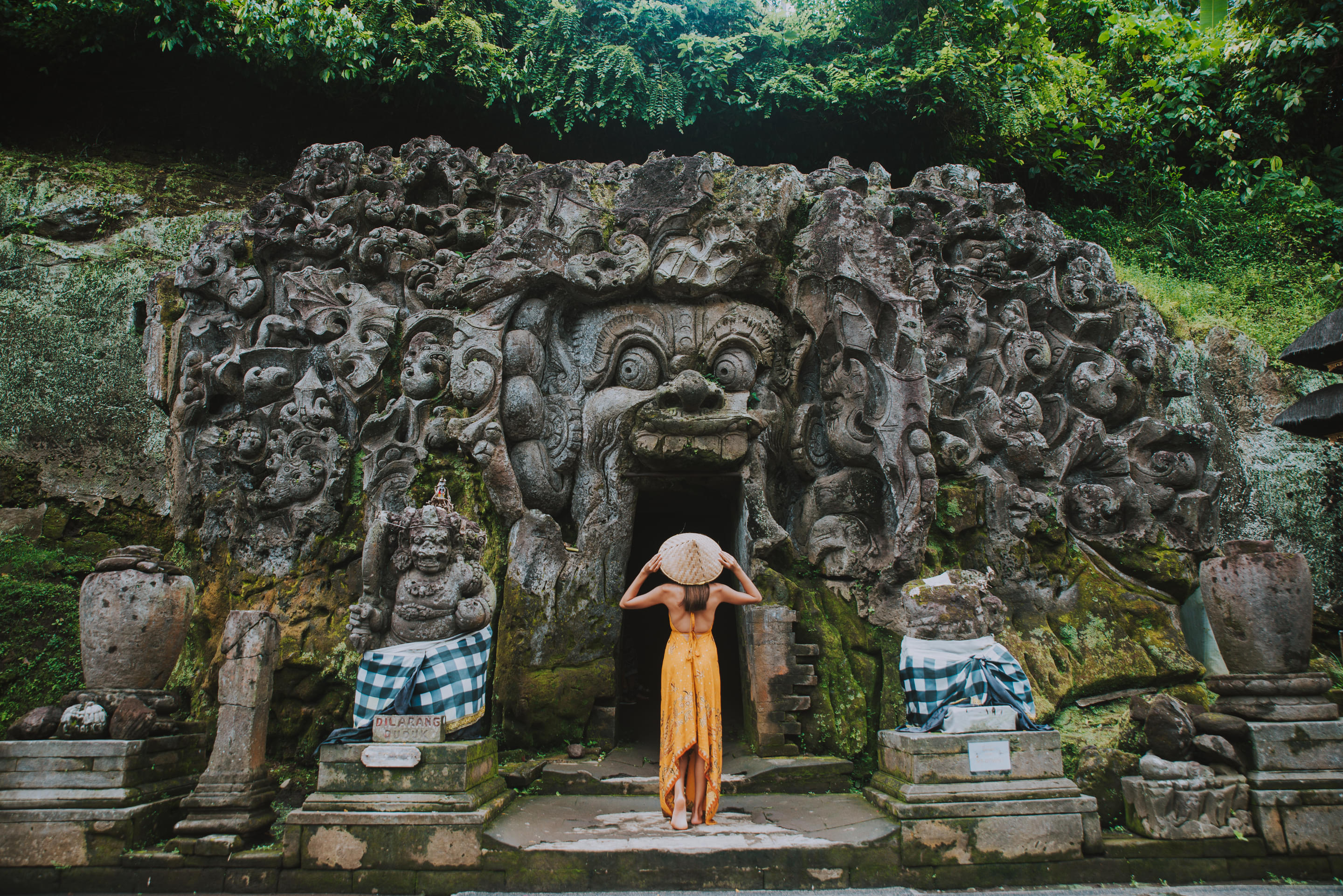About Goa Gajah
Goa Gajah, also known as the Elephant Cave, is an ancient religious sanctuary in Bali Indonesia dating back to the 11th century. It houses several Hindu and Buddhist treasures illustrating the richness of Indonesia's architectural and cultural heritage
The main attraction of the Goa Gajah is a narrow cave that is guarded by a wide-eyed demon-like edifice. Inside the cave, there are lingas depicting Lord Shiva and his son and a yoni depicting his wife Parvati. A statue of Lord Ganesha, Shiva's son is also there. There is a little space in the cave that is ideal for meditation and it also has statues of goddess Ratu Brayut and Ratu Jhempinis. An elephant-like structure at the cave's entrance is believed to ward off evil which gives it the name Elephant Cave.
Planning A Trip to Bali, Click Here To Book Our Bali Tour Packages From India Now!
There is a large meeting hall in the complex that houses a collection of religious sculptures representing the Balinese culture. Six female statues fill two sacred bathing ponds with the holy water, which is believed to have healing properties and heavenly attributes. The complex also has a Buddhist section located downhill where a Buddha statue once stood.
Goa Gajah is a perfect example of architecture and religious marvel where both Hindu and Buddhist elements coexist. It draws a huge number of tourists for its religious and archaeological values and also for its tranquil environs and lush surroundings.
Click Here to Book Now: Goa Gajah Tour With Tirta Empul Temple & Tegenungan Waterfall
Goa Gajah Highlights
• The Goa Gajah Complex combines Hindu and Buddhist elements and emits a calm aura, making it a worthwhile stop on your Bali journey.
• This venerated place attracts both tourists and devotees with its magnificent cave, ancient treasures, and sacred bathing pools.
• The cave's entrance resembles a monstrous mouth, creating the illusion of entering an unknown world through the darkness.
• The Hindu relics housed within the cave depict Hindu God Shiva, Goddess Parvati, and Lord Ganesha, making it a revered site for Hindus.
• Six waterspouts, each held by a female figure, provide holy water for two square bathing pools, adding to the place's divinity and allure.
• Another highlight of Goa Gajah is its picturesque surroundings, including rice farms, gardens, and stone steps leading to the Buddhist section, Jungle Temple, and pristine Elephant River.
How To Reach Goa Gajah
Goa Gajah is easily accessible by road from all local sites and cities. The best ways of transportation to reach this famous location are by motorcycle or cab. If you're visiting Goa Gajah by car, the road is well-signposted. Parking is available at the site at a nominal fee.
Must Read: Amazing Temples in Bali
Best Time To Visit Goa Gajah
The best time to visit Goa Gajah is during the dry season, which lasts from April to October. The best time to visit, however, is early in the morning, when the weather is pleasant and the outdoor exploration experience is delightful. It's also the best time to avoid crowds, allowing you to easily explore the complex.
Click Here to Book Now: Tegalalang Rice Terrace Tour
Goa Gajah Other Essential Information
Tips for visiting Goa Gajah
- Follow the strict dress code to access the temple complex. Avoid offending religious sensibilities.
- Wear anything that covers your knees and shoulders at all times. Sarong, scarf, or sash must be worn around the waist by both men and women.
- Sarongs and sashes are available for free at the temple for use.
- Menstruating women are not allowed inside the temple, so keep this in mind while making your travel arrangements.
- Plan your trip only if you are able to comfortably ascend and descend the stairs.
- Wear comfortable footwear because exploring the complex will require a lot of walking.
- Hire a tour guide to learn the temple's rich history and cultural significance.
Planning to Visit Bali for Honeymoon? Click Here to Book Now: Bali Honeymoon Tour Packages
Places to Stay near Goa Gajah
- Beehouse Dijiwa Ubud (1.9 km): Located in the middle of the rice terraces, it features exquisitely constructed villas that overlook a lovely pool lagoon. Each villa is constructed entirely of natural materials such as bamboo, wood, and stone, ensuring an eco-friendly stay. The resort is exclusively for adults (18+) and provides complete solitude and first-class amenities.
- Ubud Dedari Villas (1.0 km): This property is located on the Petanu River's bank, overlooking a thick rainforest, and offers a rejuvenating escape from the city's chaos in the heart of nature. Among the hotel's amenities feature an infinity pool, a gym, and a complimentary airport shuttle.
- Damuh Guest House (2.0 km): This property is a reasonably priced option for lodging in the Goa Gajah area. It offers its visitors everything they need, including spacious and well-equipped rooms with complimentary breakfast. Additionally, it provides a bicycle rental shop, an airport shuttle, free Wi-Fi, and free parking to make your stay more convenient.
- Mancur Guesthouse (300 m): It is one of the most comfortable and budget-friendly accommodation options near Goa Gajah. It offers a wide range of amenities, including an outdoor swimming pool, free Wi-Fi, free parking, a garden, a terrace, and a 24-hour front desk. Additionally, it provides airport transportation services for its occupants
Also Check: Best Hotels in Ubud
Explore the Ancient Cave
The demon's mouth at the entrance to the Elephant Cave leads to a small T-shaped hall through a dark and narrow path. The hall houses stone lingams wrapped in different colored clothes, symbolizing God Shiva, his son Lord Ganesha, and his female counterpart Yoni. Each of these idols holds a great religious significance for Hindus.
Additionally, there is a statue of Ganesha, the Hindu God who has the face of an elephant. There are black soot streaks on some of the cave's walls from previous incense fires, as well as some etchings on the walls indicating how the priest meditated in the past.
You May Also Like: Offbeat Things to Do in Ubud
Balinese Art
The entrance wall of the cave as well as the walls of the hall are adorned with a kaleidoscope of landscapes, monsters, and people carvings depicting ancient Balinese Art. You can see sculpted mountain scenes, trees, interlaced leaves, stones, and ocean waves inside the cave. The engravings of animals, demons, and phantoms running in terror from the cave's entrance also represent ancient Balinese tales through art.
Also Check and Book: Traditional Handicraft Tour in Ubud
Lush Green Paddy Fields
Goa Gajah's natural splendor is as captivating as its historical and religious significance. The rice paddies are a lovely place to visit after exploring Elephant Cave. Take a stroll through the beautiful countryside to the rice paddies and learn how rice farmers cultivate and harvest rice. Visit a traditional home to learn more about the culture of the Balinese people.
Take in the breathtaking scenery while learning about the island's people and their way of life. Don't forget to capture these beautiful scenery on your lovely trip.
Also Check and Book: Rice Field Trekking in Ubud
Ancient Stone Steps
A set of ancient stone steps lead down to the Goa Gajah complex from the parking. These are tucked away in the shade of towering trees, resulting in an enchanting scene and a chilly atmosphere. From these stairs, one can overlook the entire complex of Goa Gajah. Many other stone stairways lead to the sacred pools, meditation area, Elephant cave, the Buddhist section, rice paddies, and an enchanting forest. These stone stairways are great examples of ancient architecture of Bali.
Click Here to Book Now: Best Temple Tour of Bali
Tourism Board Alliances
Goa Gajah FAQs
Where is Goa Gajah temple located?
The temple complex is located at the banks of Bedulu river just 150 meters from the entrance of the Goa Gajah Cave.
You May Also Like: Best Places to Visit in Ubud
Is Goa Gajah worth visiting?
Yes, taking you back to the ancient times with relics of history depicting legends of Hindu mythology, Goa Gajah is definitely one of the best places to visit in Bali.
Planning to Visit Bali? Click Here to Book Now: Bali Tour Packages
Which are the popular adventure sports in Bali?
There are several adventure sports in Bali:
- Water Rafting in Bali
- Mount Batur Sunrise Trekking in Bali
- Surfing at Canggu Beach in Bali
- River Tubing in Bali
- Swimming with Sharks in Bali
Must Read: Ultimate Bali Adventure Tours
What are the other activities to enjoy in Bali that you can book through Thrillophilia?
Here are some of the activities to enjoy in Bali that you can book through Thrillophilia:
1. Finns Beach Club Bali Day Pass
5. Upside Down World Bali Tickets
9. Mount Batur Sunrise Trekking
10. Bali Safari and Marine Park Ticket
What are the different Bali packages that you can book from various Indian cities through Thrillophilia?
Here are some famous Bali packages that you can book from various Indian cities through Thrillophilia:
What are the different types of Bali day & night packages that you can book with Thrillophilia?
Here are the different types of Bali day & night tour packages that you can book with Thrillophilia:
Goa Gajah Reviews




.jpg?w=340&dpr=2)





.jpg?w=340&dpr=2)
.jpg?w=340&dpr=2)














%20(1).jpg?w=1280&dpr=1)





